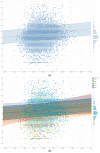Parental Educational Attainment, the Superior Temporal Cortical Surface Area, and Reading Ability among American Children: A Test of Marginalization-Related Diminished Returns
- PMID: 34070118
- PMCID: PMC8158386
- DOI: 10.3390/children8050412
Parental Educational Attainment, the Superior Temporal Cortical Surface Area, and Reading Ability among American Children: A Test of Marginalization-Related Diminished Returns
Abstract
Background: Recent studies have shown that parental educational attainment is associated with a larger superior temporal cortical surface area associated with higher reading ability in children. Simultaneously, the marginalization-related diminished returns (MDRs) framework suggests that, due to structural racism and social stratification, returns of parental education are smaller for black and other racial/ethnic minority children compared to their white counterparts.
Purpose: This study used a large national sample of 9-10-year-old American children to investigate associations between parental educational attainment, the right and left superior temporal cortical surface area, and reading ability across diverse racial/ethnic groups.
Methods: This was a cross-sectional analysis that included 10,817 9-10-year-old children from the Adolescent Brain Cognitive Development (ABCD) study. Parental educational attainment was treated as a five-level categorical variable. Children's right and left superior temporal cortical surface area and reading ability were continuous variables. Race/ethnicity was the moderator. To adjust for the nested nature of the ABCD data, mixed-effects regression models were used to test the associations between parental education, superior temporal cortical surface area, and reading ability overall and by race/ethnicity.
Results: Overall, high parental educational attainment was associated with greater superior temporal cortical surface area and reading ability in children. In the pooled sample, we found statistically significant interactions between race/ethnicity and parental educational attainment on children's right and left superior temporal cortical surface area, suggesting that high parental educational attainment has a smaller boosting effect on children's superior temporal cortical surface area for black than white children. We also found a significant interaction between race and the left superior temporal surface area on reading ability, indicating weaker associations for Alaskan Natives, Native Hawaiians, and Pacific Islanders (AIAN/NHPI) than white children. We also found interactions between race and parental educational attainment on reading ability, indicating more potent effects for black children than white children.
Conclusion: While parental educational attainment may improve children's superior temporal cortical surface area, promoting reading ability, this effect may be unequal across racial/ethnic groups. To minimize the racial/ethnic gap in children's brain development and school achievement, we need to address societal barriers that diminish parental educational attainment's marginal returns for middle-class minority families. Social and public policies need to go beyond equal access and address structural and societal barriers that hinder middle-class families of color and their children. Future research should test how racism, social stratification, segregation, and discrimination, which shape the daily lives of non-white individuals, take a toll on children's brains and academic development.
Keywords: adolescents; brain development; child; cortical surface; magnetic resonance imaging; population groups; reading; school performance; socioeconomic factors.
Conflict of interest statement
The authors declare no conflict of interest. The content is solely the responsibility of the authors and does not necessarily represent the official views of the NIMH Data Archive or the National Institutes of Health.
Figures










Similar articles
-
Parental Education, Household Income, and Cortical Surface Area among 9-10 Years Old Children: Minorities' Diminished Returns.Brain Sci. 2020 Dec 9;10(12):956. doi: 10.3390/brainsci10120956. Brain Sci. 2020. PMID: 33317053 Free PMC article.
-
Parental Education on Youth Inhibitory Control in the Adolescent Brain Cognitive Development (ABCD) Study: Blacks' Diminished Returns.Brain Sci. 2020 May 21;10(5):312. doi: 10.3390/brainsci10050312. Brain Sci. 2020. PMID: 32455841 Free PMC article.
-
Parental Educational Attainment and Black-White Adolescents' Achievement Gap: Blacks' Diminished Returns.Open J Soc Sci. 2020 Mar;8(3):282-297. doi: 10.4236/jss.2020.83026. Open J Soc Sci. 2020. PMID: 32368561 Free PMC article.
-
Eliminating racial disparities in dementia risk by equalizing education quality: A sensitivity analysis.Soc Sci Med. 2022 Nov;312:115347. doi: 10.1016/j.socscimed.2022.115347. Epub 2022 Sep 12. Soc Sci Med. 2022. PMID: 36162365 Free PMC article. Review.
-
Parental correlates of physical activity in children and early adolescents.Sports Med. 2006;36(1):79-97. doi: 10.2165/00007256-200636010-00006. Sports Med. 2006. PMID: 16445312 Review.
Cited by
-
Chasing a dream against all odds.BMC Public Health. 2022 Sep 15;22(1):1748. doi: 10.1186/s12889-022-14130-8. BMC Public Health. 2022. PMID: 36109735 Free PMC article.
-
Immigration Status, Educational Level, and Perceived Discrimination in Europe.Int J Environ Res Public Health. 2023 Jan 26;20(3):2222. doi: 10.3390/ijerph20032222. Int J Environ Res Public Health. 2023. PMID: 36767588 Free PMC article.
-
Financial Strain Partially Explains Diminished Returns of Parental Education in the ABCD Study.Open J Neurosci. 2024;2(1):25-34. doi: 10.31586/ojn.2024.1129. Epub 2024 Nov 21. Open J Neurosci. 2024. PMID: 39734514 Free PMC article.
-
Weaker Effects of Parental Education on Oral Nicotine Use of High School Students in Rural Areas: Marginalization-Related Diminished Returns.Open J Educ Res. 2025;5(2):6042. doi: 10.31586/ojer.2025.6042. Epub 2025 Mar 20. Open J Educ Res. 2025. PMID: 40256638 Free PMC article.
-
Social Determinants of Mental, Physical, and Oral Health of Middle-Aged and Older African Americans in South Los Angeles.Int J Environ Res Public Health. 2022 Dec 14;19(24):16765. doi: 10.3390/ijerph192416765. Int J Environ Res Public Health. 2022. PMID: 36554645 Free PMC article.
References
-
- Reardon S.F., Galindo C. The Hispanic-White Achievement Gap in Math and Reading in the Elementary Grades. Am. Educ. Res. J. 2009;46:853–891. doi: 10.3102/0002831209333184. - DOI
-
- Hemphill F.C., Vanneman A. Achievement Gaps: How Hispanic and White Students in Public Schools Perform in Mathematics and Reading on the National Assessment of Educational Progress. National Center for Education Statistics, Institute of Education Sciences, U.S. Department of Education; Washington, DC, USA: 2011. Statistical Analysis Report NCES 2011-459.
-
- Barton P.E. Parsing the Achievement Gap: Baselines for Tracking Progress. Policy Information Report. [(accessed on 5 May 2021)];2003 Available online: https://www.ets.org/research/policy_research_reports/publications/report....
LinkOut - more resources
Full Text Sources
Miscellaneous

